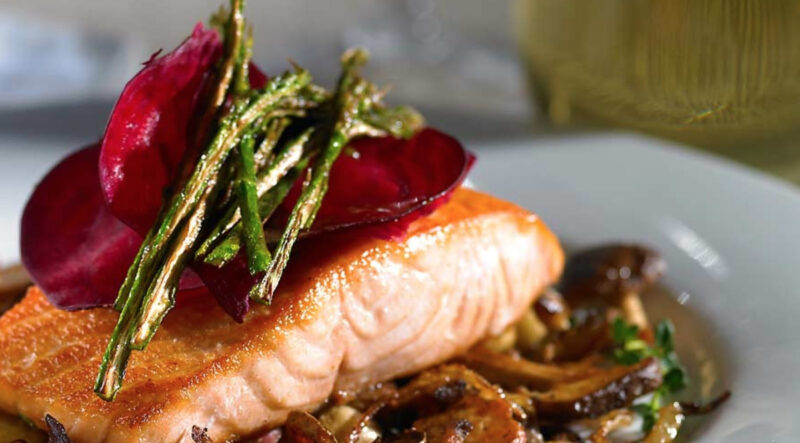Farmed salmon is critical for Canada’s food security
The salmon served on most Canadian plates comes from farms, not from the wild, and this takes the pressure off wild stocks.
Commentary
By Timothy Kennedy
Climate change is creating severe challenges for the world’s food production and distribution systems.
Rising temperatures, changing precipitation patterns and more frequent and catastrophic weather events are having damaging impacts on our food supply. Our planet is now home to eight billion people but over the past 60 years our changing climate has reduced global agricultural productivity by approximately 21 per cent.
That amounts to seven years of growth, according to recent research out of Cornell University’s School of Applied Economics and Management.
As COP15 wrapped just a few days ago in Montreal, we saw important progress on biodiversity targets and an opportunity for Canadian aquaculture to play a significant role. Specifically, the COP15 agreement spotlighted the need for sustainable management of fisheries and aquaculture by increasing biodiversity friendly practices, and implementing innovative approaches that contribute to the resilience of food production and security. Canada’s aquaculture sector will play an important role in delivering this global target – and is further supported by our new National Commitments for salmon production.
We cannot continue as we always have and expect to feed a growing world. We need to invest in more resilient food production systems that weather the challenges of climate change and population demand to ensure safe, secure, and sustainable food supplies, now and into the future. Salmon farmers in Canada are uniquely positioned to play a role in supporting this endeavour.
Consider salmon farming in the context of some of the recent challenges Canada has faced. On the west coast this past autumn, historic drought affected river levels that prematurely killed off tens of thousands of wild salmon in British Columbia, while ocean-raised salmon were unaffected, without interruption to supply.
On the east coast, Hurricane Fiona was the costliest and most intense post-tropical cyclone to hit Canada. Structurally sound salmon farms in Atlantic waters navigated this storm and its aftermath with little interruption.
Extreme weather events related to climate change will continue to raise food scarcity risks which means sustainable solutions like salmon farming are essential, especially in a country like Canada, which is a world leader in aquaculture science and innovation.
There is rising demand for seafood worldwide, and salmon specifically based on its health benefits, ease of preparation, and taste. However, there is no more wild salmon to be caught to provide for increasing demand.
Salmon farms in B.C. have started to address the global pressure on supply and demand, which is projected to increase by 40 per cent (almost two million tonnes) by 2027. That upward consumption trend is also reflected in Canada, with Canadians consuming more salmon in their diet than ever before.
Farm-raised salmon makes up almost all salmon produced in Canada. The salmon served on most Canadian plates comes from farms, not from the wild. Salmon farming takes the pressure off wild stocks to aid in their recovery. Farms are a benefit to wild salmon just as they are a benefit to Canadians because sustainable, farm-raised salmon is one of the most climate-friendly foods anywhere in the world.
To ensure the sustainability and security of farm-raised salmon, Canada’s salmon farmers began discussions in 2021 to develop National Commitments for the industry. Today we are proud to present these commitments to Canadians and the world. These National Commitments are the result of inputs from a diverse list of expert stakeholders and rightsholder groups from Canada’s east and west coasts. Designed to support the strong values that all Canadians share, these commitments outline the priority areas for careful and continuous improvement in salmon farm operations. These priority areas include new standards for food security, climate change, ocean health, fish health, food traceability, public reporting, and sustainable feed, supported by actions and targets that the industry launched this month. Canada’s salmon farmers are committed to fully achieving our National Commitments by 2032, including a commitment to transparently report on our progress each year.
Salmon farms have come a long way since raising the first salmon in Canada just over forty years ago and farming practices will continue to improve to meet the increasing demand for environmentally responsible, nourishing food. Salmon farmers in Canada are committed to being the very best producers of farm-raised salmon and a global leader in sustainable aquaculture.
With the longest coastline of any country on Earth, Canada has the greatest cold-water aquaculture opportunity in the world. As the global population continues to grow, Canada should lead the charge in providing salmon to the world in a sustainable way that creates economic growth in coastal and Indigenous communities, contributes to the country’s goals of reducing climate impacts, protects our oceans and wild salmon, and provides a safe, secure food source for Canadians.
I invite you to view our National Commitments by visiting www.lovesalmon.ca
(Timothy Kennedy is president and CEO of the Canadian Aquaculture Industry Alliance)

